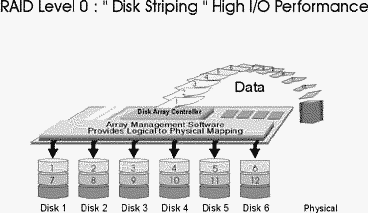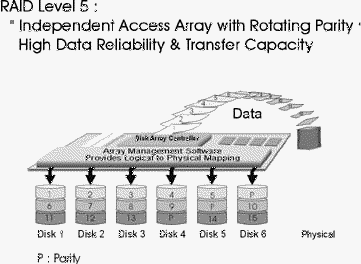
Financial Ltd
|

Directory Enquiries

Currency Converter

Train Tickets



|
| |
|
This
is another way to look at RAID. As you can see there is
not much to it.
|
RAID 0, Striping.
The first thing to realise
with RAID 0 is that it doesn't provide redundancy, so by definition it
isn't truly RAID. If even a single drive in a RAID 0 set goes faulty, then
all of the data on the set is lost. However, RAID 0 does provide
the fastest I/O rates of the RAID levels.
RAID 0 gets it's performance
from striping the data across all of the drives in the set. One way of
explaining this would be to imagine a controller connected to a group of
drives which spreads the data across all of the disks. Because it is
sending data to several drives at once, it is able to do so quickly. The
same is true for reading.
|
|

|
Characteristics
 |
Striped
disk array, the data is broken down into blocks and each block is
written to a seerate disk drive.
|
 |
I/O
performance is greatly improved by spreading the I/O load across
many channels and drives.
|
 |
Fastest
and most efficient array type but offers no fault tolerance.
|
 |
RAID
0 requires at least 1 drive
|
|
|
Recommended use
 |
Video
production and editing
|
 |
Image
editing
|
 |
Pre-press
applications
|
 |
Any
application requiring high bandwidth
|
|
Redundant Array of Inexpensive
Disks. The term was coined in a paper by Patterson,
Gibson and Katz in 1988.
"While the capacity of Single Large
Expensive Disks (SLED) has grown rapidly, the performance improvement of SLED
has been modest. Redundant Arrays of Inexpensive Disks (RAID), based on the
magnetic disk technology developed for personal computers, offers an attractive
alternative to SLED, promising improvements of an order of magnitude in
performance, reliability, power consumption, and scalability."
The main idea of RAID is to provide
a group of drives in a system that will continue to provide valid uninterrupted
data even if one (or sometimes more) drives fail. Secondary benefits are faster
access speeds and data transfer as well as the ability to publish virtual disk
drives to the host system that are far larger than a single drive.
RAID comes in several different
configurations, which are notated RAID X, with X being a number. The most
commonly used are RAID 0, RAID 1, and RAID 5, with RAID 3 and RAID 0+1 making
occasional appearances. RAID 2 and 4 are almost never used. Each has it's own
strengths and weaknesses which I will explain next. Use the links below.


RAID 0+1, Striping and Mirroring.
This is striping and mirroring
combined. Data is striped across several disks, each disk has partner with
exactly the same data on it.
You get the benefits of fast
data access as in RAID 0, with the fault tolerance of RAID 1. You need
double the number of disks as a RAID 0, half for each side of the mirror.
|
|
Characteristics
 |
Optimal
speed and reliability
|
 |
High
use of drives, RAID 0+1 requires twice as many drives as RAID 0
|
|
Recommended use
 |
Any
application requiring high bandwidth as well as high fault
tolerance.
|
|


RAID 5, Striped data, striped
parity.
An adaptation of RAID 3, RAID
5 spreads the parity information across all of the drives instead of using
a dedicated drive. This gives a performance benefit compared to RAID 3,
where the dedicated parity drive is written to on every write operation,
this load is spread across all of the drives in RAID 5. This still only
requires an overhead of one drive.
RAID 5 is the most commonly
chosen RAID configuration, giving fault tolerance and good performance.
|
|

|
Characteristics
 |
The
data is striped across a set of disks and parity information
calculated and striped as well.
|
 |
Highest
Read data rate, medium Write rate.
|
 |
RAID
5 requires a minimum of 3 drives.
|
|
|
Recommended use
 |
File
and application servers.
|
 |
Database
servers
|
 |
Intranet
servers
|
 |
Most
versatile RAID level.
|
|

|